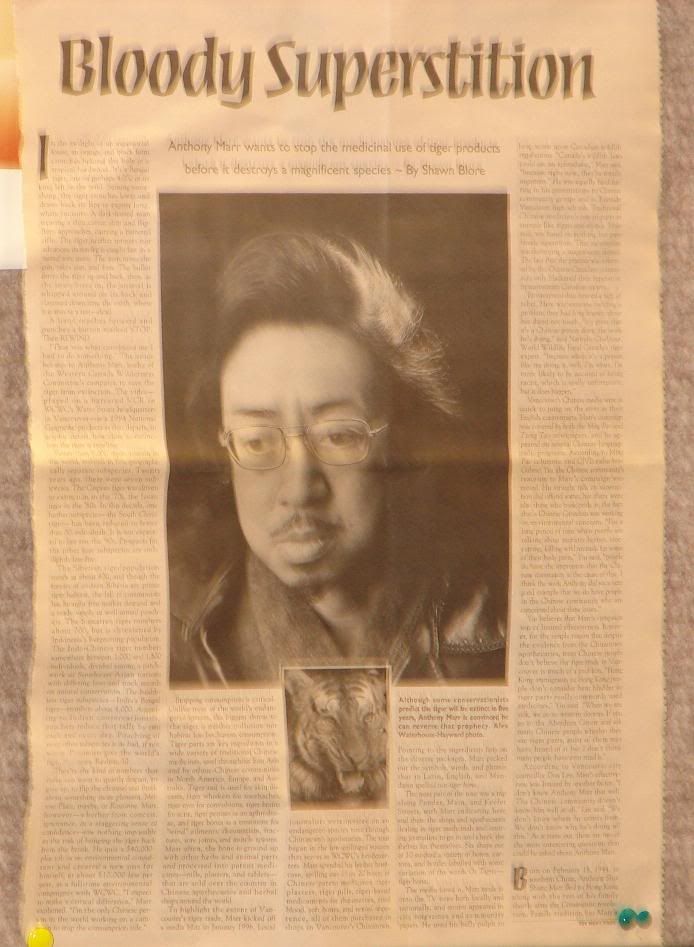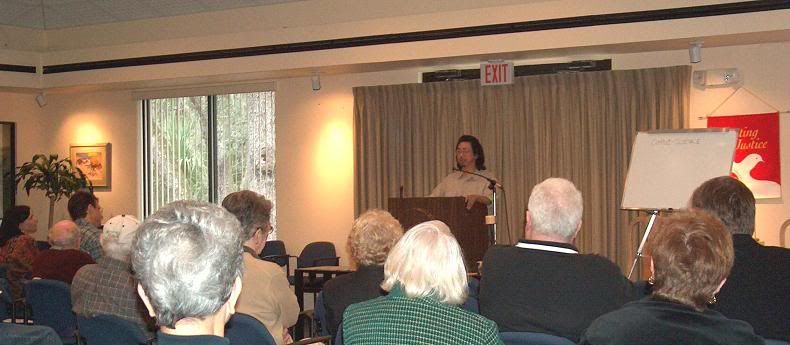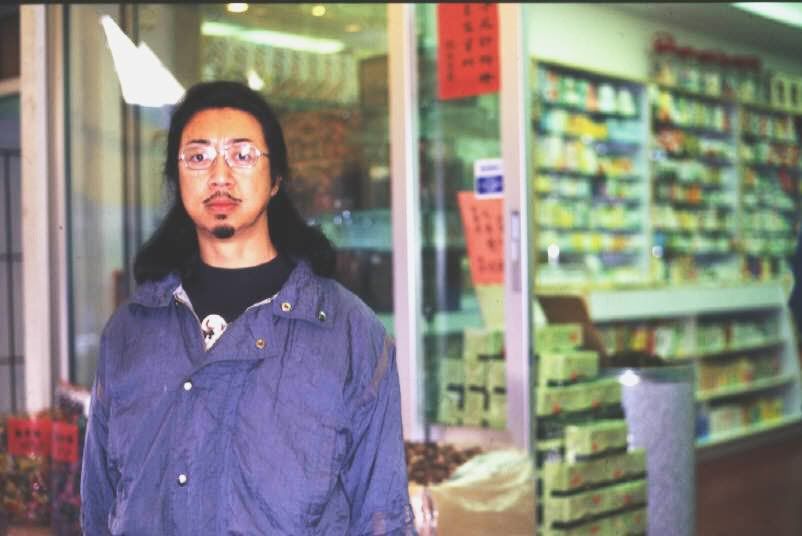Bloody Superstition and Revolutionary Cosmology
On April 24, 1997, a controversial cover article appeared in the Vancouver underground-gone-aboveground magazine the Georgia Straight, titled "Bloody Superstition", by the famed journalist Shawn Blore. Given its being a well written summary of the beginning of my full time activism in 1995, preceded by my solo camping adventure experience in Africa almost two decades prior, I will present it verbatim below. This will serve to lead up to the long hot summer of 1996 to be told in [ON MY WAR PATH - 005].

BLOODY SUPERSTITION
by Shawn Blore
July 24, 1997
Georgia Straight Magazine
Vancouver, BC, Canada
Pessimist give the world's tigers 5 years. Realists, 10.
They're the kind of number that make you want to quietly despair, to give up, to flip the channel and think about something more pleasant. Melrose Place maybe, or Roseanne. Anthony Marr, however, whether from a sense of conceit, ignorance, or a staggering sense of confidence, saw nothing impossible in the task of bringing the tiger back from the brink...
... To highlight the extent of Vancouver's tiger trade, Marr kicked off a media blitz in November 1995. Local journalists were invited on an endangered species tour through Chinatown's apothecaries. The tour began in the low-ceilinged warren that serves as Western Canada Wilderness Committee's headquarters. Marr upended his briefcase, spilling out 15-20 boxes of Chinese patent medicines: tiger plasters, tiger pills, tiger-based medicaments for rheumatism, tired blood, soft bones, and sexual impotence, all of them purchased in shops in Vancouver's Chinatown. Pointing to the ingredients lists on the diverse packages, Marr picked out the symbols, words, and phrases that in Latin, English and Chinese spelled out “tiger bone”.
The next part of the tour was a trip along Pender, Main and Keefer Streets, with Marr indicating here and there the shops and apothecaries dealing in tiger medicinals and inviting journalists to go in and check the shelves for themselves. Six shops out of 10 stocked a variety of boxes, cartons and bottles labeled with some variation of the word Os Tigris - tiger bone.
The media loved it. Marr made it on to TV news both locally and nationally, and stories appeared in city magazines and community papers. He used his pulpit to heap scorn upon Canadian wildlife regulations. “Canada's wildlife laws could use an aphrodisiac,' Marr said, “because right now, they're totally impotent.” He was equally hard-hitting in his presentations to Chinese community groups and at Eastside Vancouver high schools. Traditional Chinese medicine's use of parts of animals like tigers and rhinos, Marr said, and the cutting of many urban trees for that matter, were based on nothing but pure superstition. That superstition was destroying a magnificent species. The fact that the practice was tolerated by the Chinese-Canadian community only blackened their reputation in mainstream Canadian society.
Environmentalists heaved a sigh of relief. Here was someone tackling a problem they had long known about but dared not touch. “It's great that it's a Chinese person doing the work he's doing.” said Nathalie Chalifour, World Wildlife Fund Canada's tiger expert, “because when it's a person like me doing it, well, I'm white; I'm more likely to be accused to being racist, which is really unfortunate, but it does happen.”
Vancouver's Chinese media were as quick to jump on the story as their English counterparts. Marr's campaign was covered by both the Ming Pao and the Sing Tao newspapers, and he appeared on several Chinese language radio programs. According to Ming Pao columnist and CJVB radio host Gabriel Yiu, the Chinese community's reaction to Marr's campaign was mixed. His straight talk on superstition did offend some, but there was also those who took pride in the fact that a Chinese Canadian was working on environmental concerns. “For a long period of time when people are talking about monster homes, tree cutting, killing wild animals for some of their body parts,” Yiu said, “people do have the impression that the Chinese community is the cause of that. I think the work Anthony did set a very good example that we do have people in the Chinese community who are concerned about these issues.”...
According to Vancouver city councilor Don Lee, Marr's effectiveness was limited... “I don't know Anthony Marr that well. The Chinese Community doesn't know him well at all,” Lee said. “We don't know where he comes from. We don't know why he's doing all this.” As it turns out, those are two of the most interesting questions that could be asked about Anthony Marr..."
Born in February 1944, in southern China, Anthony Seeu-Sung Marr fled to Hong Kong along with the rest of his family shortly after the Communist revolution. Family legend has Marr's father burning the deeds of the family's extensive land-holdings for a moment's warmth during the first refugee winter...
(In 1965), Marr came to Canada to study science at the University of Manitoba... At the same time, his relationship with a Hong Kong girl fell to bits when she dropped him on orders from her parents. Marr has never forgiven Chinese culture for the snub. “As a result of that incident, I have never dated a Chinese girl again,” Marr said. It's a decision that isolated him somewhat from the Chinese community, but, according to Marr, it also allowed him to integrate more fully into Canadian society than other Chinese immigrants of his generation.
In 1966, Marr switched over to the physics department of the University of British Columbia. His summers he spent in the bush in northern Manitoba and British Columbia, working as a geologist's assistant. It was work that can only be idealized by someone who has never done it. Marr said, “The student is the geologist's personal servant - more like slave, considering the pay, which was only $280 per month. I made and carried his lunch, and every few feet, the geologist would pick up a rock sample about twice the size of my fist and drop it into my knapsack. I had to carry that ever-heavier thing all day, wading into swamps that would sometimes come up to my chest or higher. Your shirt would be black with flies and mosquitoes. There could be a bear behind every tree. It was brutal, but also absolutely beautiful. And this was how I bonded with nature.”
After he graduated with a B.Sc. in 1970, Marr took a job as a live-in house-father for emotionally disturbed kids, then a career in real estate. He said he had a heavy student loan to pay off. One senses he also had a need to gain acceptance among the Vancouver business community. “I made rookie of the year, then Gold Club, Diamond Club, all that,” Marr said. “I bought a couple of horses - hunters-jumpers - and got involved with the high social elite you see down in Southlands.” Snap shots from the time show a short-haired Marr in boots and riding breeches, sitting atop a bay Thoroughbred gelding.
The real estate phased continued for several years. Marr bought a small acreage in the suburbs. He dated but never married. “The work first became routine, then boring, then irksome, then unbearable. I was still good at it, but the initial challenge was gone,” he said.
About this time, things took a strange turn. Whether from boredom, a need to be alone, or perhaps simple a desire to see the sights, he left his job and set off on a solo journey in East Africa, primarily in the Kilimanjaro, Serengeti, Ngorongoro Crater and Olduvai Gorge region of Tanzania. At some point during that three month sojourn, something happened that changed the whole focus of Marr's life. “If you want to be dramatic, you could say it came to me all at once in a blinding flash while I was camping on the savannah, but really, it developed very gradually.” What Marr was catching sight of was a completely new philosophical system, one that in Marr's view is comprehensive enough to explain the organization and development of life, society and the Cosmos itself.
The full tenet of this system came to him in dribs and drabs over a period of many months during and after his return. Marr collected each of these thoughts on a file card - more than 1,000 of them by the end - and worked at ordering, arranging, and reordering them, trying to assemble his thoughts into a coherent whole. The process took years. Marr's live-in girlfriend walked out. “I really shouldn't be living with someone at that point," Marr said. “I had to have my own room. I had to have a ‘DO NOT DISTURB’ sign on the door, and if anybody as much as knocked, my tenuous mental construct would fall down like a house of cards.” The net result of his shuffling and reshuffling, typing and retyping, was a manuscript more than 800 pages in length, describing a new and comprehensive philosophical and phenomenological system. Marr christened it OMNI-SCIENCE....
At first glance, OMNI-SCIENCE bears some resemblance to the ideas of the Jesuit philosopher-scientist Pierre Teilhard de Chardin. Both suggest that the development of humanity must logically proceed in a converging upward spiral, which Marr calls Integrative Transcendence, towards ever-superior levels of organization and unity. Marr, however, is quick to point out how his system differs from those of other western philosophers. “No philosophical or religious system I’ve encountered is cosmic enough,” said Marr. “They're too anthropocentric, too narrowly focused.” Marr's system purportedly incorporates everything - inorganic and organic - throughout the Universe, from the Big Bang to whatever end, all participating in the multi-levelled Integrative Transcendence spiral towards universal life and consciousness.
Hogwash? Possibly. Even Marr himself had doubts (about the acceptability of his system in the eyes of high academia). In the late 80s, Marr tossed both manuscript and portable type-writer into his little green Toyota Celica and set off down the West Coast to test his system with the best academic minds he could find. One of the stops was the University of California at Berkeley, and another was Stanford. “This was when my sales training paid off. When I got to town, the first thing I'd do was find a course catalog and look up the professors who were teaching the courses I liked. Back in my hotel room, I'd crank out a dozen or so letters. ‘Dear Prof. so and so, I have a matter of philosophical interest that I'd like to discuss with you. The time required would be about two hours...’ Then I'd go back to campus and put the letters into the professors’ cubbyholes. The next day, I'd call and ask for an appointment. We'd talk for two hours, and at the end, I'd ask for a letter of critique.”

The good professors' reactions to this approach can be discerned from the letter written by William Kimbel, president of the Institute of Human Origins at Berkeley: “Owing to the large number of half-baked theories on cosmology currently in circulation, I admit that I faced the prospect of my meeting with Mr. Marr with some trepidation. From the outset, however, it was clear that Mr. Marr is no amateur populariser. On the contrary, he is a dedicated scholar whose theories, I believe, make a profound contribution to the fundamental definition of humankind in relation to the broader universe… implications of great depth and breadth for the future course of human actions… too important to ignore.”
Marr received similarly effusive letters from other professors at Berkeley, Stanford, and the Universities of Oregon, Washington and British Columbia...
Heady stuff. Yet, more than a decade later, the manuscript remains unpublished. Professor Braxton Alfred of Anthropology, UBC, said he even offered to help find a publisher, but Marr said his manuscript was not yet ready for publication. He did leave a copy of the then manuscript behind after his presentation, but due to professional pressures, Alfred didn't get around to looking at it until recently. Reading it now, Alfred said, only increases his respect for Marr. It also sheds light on what it was that set him on his current crusade.
“The presentation he gave me was hard science, very thoroughly presented. He was right on the numbers with everything in the presentation. I presumed likewise in these documents,” Alfred said, referring to the OMNI-SCIENCE manuscript, “but these are quite a different thing. That man had a revelation in Africa. There's no other way to characterize it. It's clear that he was experiencing some sort of emotional trauma, and something touched him, and what these documents record are the revealed truth of that contact.”
According to the manuscript, Alfred said, Marr had reached a crisis and was sitting in the snows of Kilimanjaro, pointing a gun at his head.
Then, as stated in Marr's text: “The sun went down, the moon came up, and more than my hand had begun trembling. It was then that this mysterious source of wisdom address me for the first time: ‘I am seeking a miracle worker, to work a miracle upon this Earth, on my behalf. Since you seem to have no further use of this body of yours, which seems to be in prime condition, will you surrender it to me?’”
“That's when the entity, or whatever it is, first made contact with him,” Alfred said, “but, apparently, the contact continues. It seems that there is no end to it. I would not be surprised if he has conversations with this entity still.”
Having read the manuscript, Alfred said he is no longer puzzled by Marr's decision to turn away from the task of perfecting his book to work on behalf of endangered species. “It was in Africa that this naturism force first came to the fore...” The manuscript also gives some indication of the source of Marr's willingness to take on seemingly hopeless causes. “He clearly came to a crisis point in his life,” Alfred said, “and the heavens opened up and truth was revealed, and he's been going strong eversince.”
Wherever his confidence came stems from, when the “‘19th-century scholar' decided to prove himself as an environmental saviour, he displayed a thoroughly 19th century sense of ambition...
… Although some conservationists predict the tiger will be extinct in five years, Anthony Marr is convinced he can reverse the prophecy…
… China imported the equivalent of 400 grown tigers and exported 27 million tiger derivative products from 1990 to 1993… About 39,000 individual tiger containing products were seized in BC in 1996, including everything from medicinals to tiger claws…
A Vancouver branch of Asian Conservation Awareness Program is planning to begin an ad blitz this June, timed to coincide with the dragon-boat festival. Ironically, Marr will likely not be invited to participate. According to ACAP's Vancouver organizer Ling Zheng, Marr's confrontational style doesn't fit in with ACAP's approach, which hinges on establishing partnerships with the Chinese community groups and obtaining sponsorship from prominent corporations. “We're trying to reach out to the Chinese community, so we try not to use his name,” Zheng said. “If we mention Anthony Marr, I will probably not get any help from organizations like SUCCESS or the Chinese Cultural Centre. He can be quite harsh towards certain Chinese people, and I've even heard that in the Chinese community he's considered like a traitor.”
Whether that’s true or not, Marr has shifted his efforts from reducing consumption into preserving tiger habitat. With the aid of a $75,000 grant from the Canadian International Development Agency, Marr has gone to India to work towards protecting two Indian tiger reserves from encroachment and poaching by local villagers. The plan is to take a traveling multi-media show to villages around the tiger reserves and convince the villagers that the tiger is worth more to them alive than dead.
“Do you think these women enjoy walking five miles every day into the bush to collect a bunch of twigs and carry it back to the village on top of their heads? They do it because they have no choice,” Marr said. “If we give them a choice and say, Look, we’re going to develop ecotourism, we’re going to organize tourist groups to come to your village, and maybe you can develop some native products to sell to them… Wouldn’t you rather stay at home and weave baskets with your kids than walk five miles to haul water?” Other conservationists from other groups have made these arguments before, often with little success, but with characteristic confidence, Marr is convinced he will succeed.

This article opened up a ranged of other articles to come, but it is worthwhile in itself.
Anthony Marr, Founder and President
Heal Our Planet Earth (HOPE)
Global Anti-Hunting Coalition (GAHC)
Anthony-Marr@HOPE-CARE.org
www.HOPE-CARE.org
www.facebook.com/Anthony.Marr.001
www.facebook.com/Global_Anti-Hunting_Coalition
www.myspace.com/AnthonyMarr
www.youtube.com/AnthonyMarr
www.HomoSapiensSaveYourEarth.blogspot.com
www.DearHomoSapiens.blogspot.com (AM's 3rd-book-in-the-making)
www.myspace.com/Anti-Hunting_Coalition
www.ARConference.org
No comments:
Post a Comment